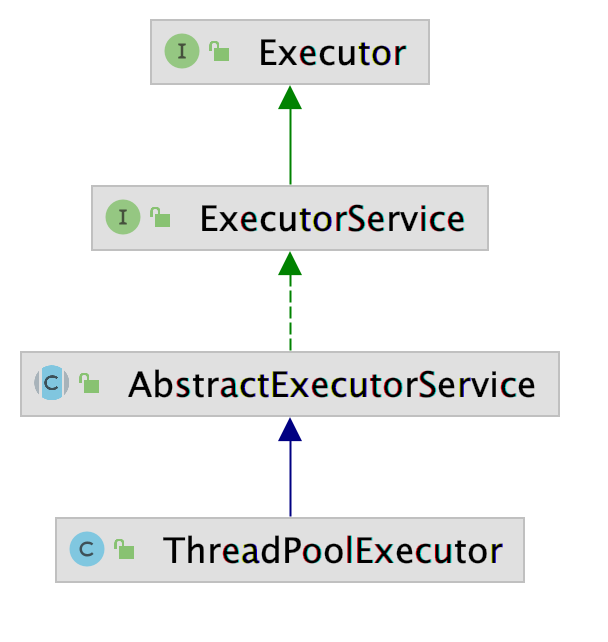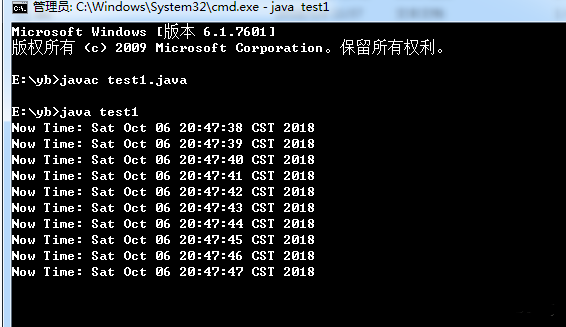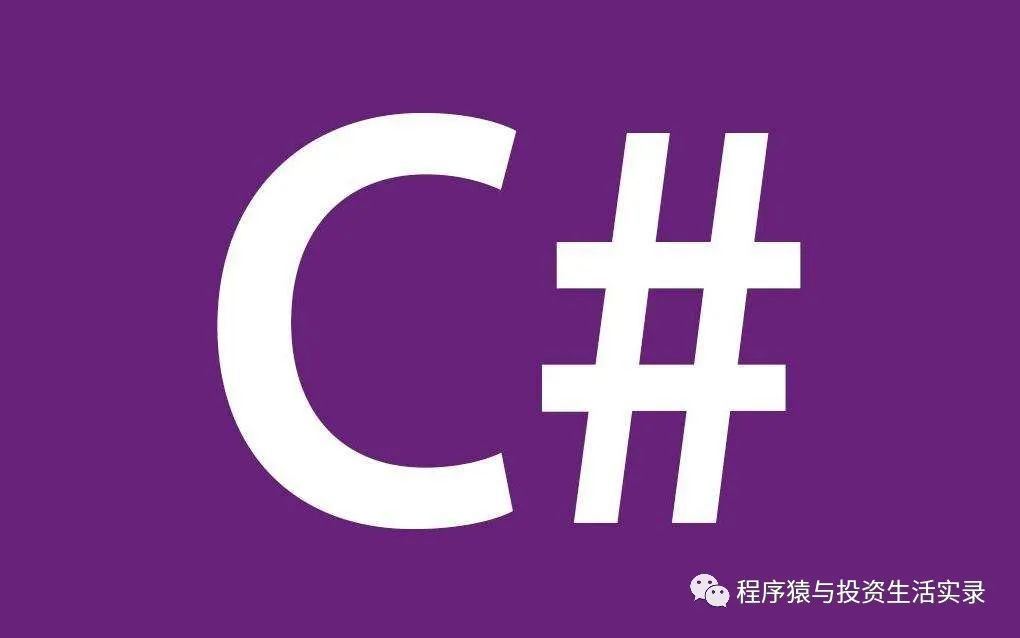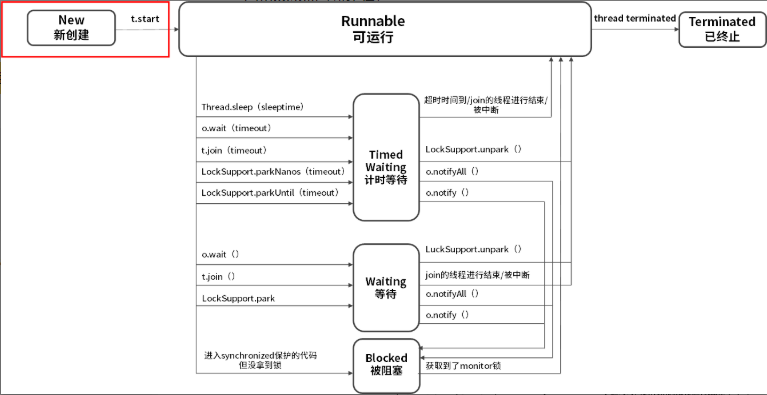停止一个线程意味着在任务处理完任务之前停掉正在做的操作,也就是放弃当前的操作。停止一个线程可以用Thread.stop()方法,但最好不要用它。虽然它确实可以停止一个正在运行的线程,但是这个方法是不安全的,而且是已被废弃的方法。在java中有以下3种方法可以终止正在运行的线程:
使用退出标志,使线程正常退出,也就是当run方法完成后线程终止。
使用stop方法强行终止,但是不推荐这个方法,因为stop和suspend及resume一样都是过期作废的方法。
使用interrupt方法中断线程。
1. 停止不了的线程
interrupt()方法的使用效果并不像for+break语句那样,马上就停止循环。调用interrupt方法是在当前线程中打了一个停止标志,并不是真的停止线程。
public?class?MyThread?extends?Thread?{ ????public?void?run(){ ????????super.run(); ????????for(int?i=0;?i<500000;?i++){ ????????????System.out.println("i="+(i+1)); ????????} ????} } public?class?Run?{ ????public?static?void?main(String?args[]){ ????????Thread?thread?=?new?MyThread(); ????????thread.start(); ????????try?{ ????????????Thread.sleep(2000); ????????????thread.interrupt(); ????????}?catch?(InterruptedException?e)?{ ????????????e.printStackTrace(); ????????} ????} }
输出结果:
... i=499994 i=499995 i=499996 i=499997 i=499998 i=499999 i=500000
2. 判断线程是否停止状态
Thread.java类中提供了两种方法:
this.interrupted(): 测试当前线程是否已经中断;
this.isInterrupted(): 测试线程是否已经中断;
那么这两个方法有什么图区别呢?我们先来看看this.interrupted()方法的解释:测试当前线程是否已经中断,当前线程是指运行this.interrupted()方法的线程。
public?class?MyThread?extends?Thread?{
????public?void?run(){
????????super.run();
????????for(int?i=0;?i<500000;?i++){
????????????i++;
//????????????System.out.println("i="+(i+1));
????????}
????}
}
public?class?Run?{
????public?static?void?main(String?args[]){
????????Thread?thread?=?new?MyThread();
????????thread.start();
????????try?{
????????????Thread.sleep(2000);
????????????thread.interrupt();
????????????System.out.println("stop?1??"?+?thread.interrupted());
????????????System.out.println("stop?2??"?+?thread.interrupted());
????????}?catch?(InterruptedException?e)?{
????????????e.printStackTrace();
????????}
????}
}
运行结果:
stop?1??false stop?2??false
类Run.java中虽然是在thread对象上调用以下代码:thread.interrupt(), 后面又使用
System.out.println("stop?1??"?+?thread.interrupted());
System.out.println("stop?2??"?+?thread.interrupted());
来判断thread对象所代表的线程是否停止,但从控制台打印的结果来看,线程并未停止,这也证明了interrupted()方法的解释,测试当前线程是否已经中断。这个当前线程是main,它从未中断过,所以打印的结果是两个false.
如何使main线程产生中断效果呢?
public?class?Run2?{
????public?static?void?main(String?args[]){
????????Thread.currentThread().interrupt();
????????System.out.println("stop?1??"?+?Thread.interrupted());
????????System.out.println("stop?2??"?+?Thread.interrupted());
????????System.out.println("End");
????}
}
运行效果为:
stop?1??true stop?2??false End
方法interrupted()的确判断出当前线程是否是停止状态。但为什么第2个布尔值是false呢? 官方帮助文档中对interrupted方法的解释:测试当前线程是否已经中断。线程的中断状态由该方法清除。 换句话说,如果连续两次调用该方法,则第二次调用返回false。
下面来看一下inInterrupted()方法。
public?class?Run3?{
????public?static?void?main(String?args[]){
????????Thread?thread?=?new?MyThread();
????????thread.start();
????????thread.interrupt();
????????System.out.println("stop?1??"?+?thread.isInterrupted());
????????System.out.println("stop?2??"?+?thread.isInterrupted());
????}
}
运行结果:
stop?1??true stop?2??true
isInterrupted()并为清除状态,所以打印了两个true。
3. 能停止的线程--异常法
有了前面学习过的知识点,就可以在线程中用for语句来判断一下线程是否是停止状态,如果是停止状态,则后面的代码不再运行即可:
public?class?MyThread?extends?Thread?{
????public?void?run(){
????????super.run();
????????for(int?i=0;?i<500000;?i++){
????????????if(this.interrupted())?{
????????????????System.out.println("线程已经终止,?for循环不再执行");
????????????????break;
????????????}
????????????System.out.println("i="+(i+1));
????????}
????}
}
public?class?Run?{
????public?static?void?main(String?args[]){
????????Thread?thread?=?new?MyThread();
????????thread.start();
????????try?{
????????????Thread.sleep(2000);
????????????thread.interrupt();
????????}?catch?(InterruptedException?e)?{
????????????e.printStackTrace();
????????}
????}
}
运行结果:
... i=202053 i=202054 i=202055 i=202056 线程已经终止,?for循环不再执行
上面的示例虽然停止了线程,但如果for语句下面还有语句,还是会继续运行的。看下面的例子:
public?class?MyThread?extends?Thread?{
????public?void?run(){
????????super.run();
????????for(int?i=0;?i<500000;?i++){
????????????if(this.interrupted())?{
????????????????System.out.println("线程已经终止,?for循环不再执行");
????????????????break;
????????????}
????????????System.out.println("i="+(i+1));
????????}
????????System.out.println("这是for循环外面的语句,也会被执行");
????}
}
使用Run.java执行的结果是:
... i=180136 i=180137 i=180138 i=180139 线程已经终止,?for循环不再执行 这是for循环外面的语句,也会被执行
如何解决语句继续运行的问题呢? 看一下更新后的代码:
public?class?MyThread?extends?Thread?{
????public?void?run(){
????????super.run();
????????try?{
????????????for(int?i=0;?i<500000;?i++){
????????????????if(this.interrupted())?{
????????????????????System.out.println("线程已经终止,?for循环不再执行");
????????????????????????throw?new?InterruptedException();
????????????????}
????????????????System.out.println("i="+(i+1));
????????????}
????????????System.out.println("这是for循环外面的语句,也会被执行");
????????}?catch?(InterruptedException?e)?{
????????????System.out.println("进入MyThread.java类中的catch了。。。");
????????????e.printStackTrace();
????????}
????}
}
使用Run.java运行的结果如下:
... i=203798 i=203799 i=203800 线程已经终止,?for循环不再执行 进入MyThread.java类中的catch了。。。 java.lang.InterruptedException ?at?thread.MyThread.run(MyThread.java:13)
4. 在沉睡中停止
如果线程在sleep()状态下停止线程,会是什么效果呢?
public?class?MyThread?extends?Thread?{
????public?void?run(){
????????super.run();
????????try?{
????????????System.out.println("线程开始。。。");
????????????Thread.sleep(200000);
????????????System.out.println("线程结束。");
????????}?catch?(InterruptedException?e)?{
????????????System.out.println("在沉睡中被停止,?进入catch,?调用isInterrupted()方法的结果是:"?+?this.isInterrupted());
????????????e.printStackTrace();
????????}
????}
}
使用Run.java运行的结果是:
线程开始。。。 在沉睡中被停止,?进入catch,?调用isInterrupted()方法的结果是:false java.lang.InterruptedException:?sleep?interrupted ?at?java.lang.Thread.sleep(Native?Method) ?at?thread.MyThread.run(MyThread.java:12)
从打印的结果来看, 如果在sleep状态下停止某一线程,会进入catch语句,并且清除停止状态值,使之变为false。
前一个实验是先sleep然后再用interrupt()停止,与之相反的操作在学习过程中也要注意:
public?class?MyThread?extends?Thread?{
????public?void?run(){
????????super.run();
????????try?{
????????????System.out.println("线程开始。。。");
????????????for(int?i=0;?i<10000;?i++){
????????????????System.out.println("i="?+?i);
????????????}
????????????Thread.sleep(200000);
????????????System.out.println("线程结束。");
????????}?catch?(InterruptedException?e)?{
?????????????System.out.println("先停止,再遇到sleep,进入catch异常");
????????????e.printStackTrace();
????????}
????}
}
public?class?Run?{
????public?static?void?main(String?args[]){
????????Thread?thread?=?new?MyThread();
????????thread.start();
????????thread.interrupt();
????}
}
运行结果:
i=9998 i=9999 先停止,再遇到sleep,进入catch异常 java.lang.InterruptedException:?sleep?interrupted ?at?java.lang.Thread.sleep(Native?Method) ?at?thread.MyThread.run(MyThread.java:15)
5. 能停止的线程---暴力停止
使用stop()方法停止线程则是非常暴力的。
public?class?MyThread?extends?Thread?{
????private?int?i?=?0;
????public?void?run(){
????????super.run();
????????try?{
????????????while?(true){
????????????????System.out.println("i="?+?i);
????????????????i++;
????????????????Thread.sleep(200);
????????????}
????????}?catch?(InterruptedException?e)?{
????????????e.printStackTrace();
????????}
????}
}
public?class?Run?{
????public?static?void?main(String?args[])?throws?InterruptedException?{
????????Thread?thread?=?new?MyThread();
????????thread.start();
????????Thread.sleep(2000);
????????thread.stop();
????}
}
运行结果:
i=0 i=1 i=2 i=3 i=4 i=5 i=6 i=7 i=8 i=9 Process?finished?with?exit?code?0
6.方法stop()与java.lang.ThreadDeath异常
调用stop()方法时会抛出java.lang.ThreadDeath异常,但是通常情况下,此异常不需要显示地捕捉。
public?class?MyThread?extends?Thread?{
????private?int?i?=?0;
????public?void?run(){
????????super.run();
????????try?{
????????????this.stop();
????????}?catch?(ThreadDeath?e)?{
????????????System.out.println("进入异常catch");
????????????e.printStackTrace();
????????}
????}
}
public?class?Run?{
????public?static?void?main(String?args[])?throws?InterruptedException?{
????????Thread?thread?=?new?MyThread();
????????thread.start();
????}
}
stop()方法以及作废,因为如果强制让线程停止有可能使一些清理性的工作得不到完成。另外一个情况就是对锁定的对象进行了解锁,导致数据得不到同步的处理,出现数据不一致的问题。
7. 释放锁的不良后果
使用stop()释放锁将会给数据造成不一致性的结果。如果出现这样的情况,程序处理的数据就有可能遭到破坏,最终导致程序执行的流程错误,一定要特别注意:
public?class?SynchronizedObject?{
????private?String?name?=?"a";
????private?String?password?=?"aa";
????public?synchronized?void?printString(String?name,?String?password){
????????try?{
????????????this.name?=?name;
????????????Thread.sleep(100000);
????????????this.password?=?password;
????????}?catch?(InterruptedException?e)?{
????????????e.printStackTrace();
????????}
????}
????public?String?getName()?{
????????return?name;
????}
????public?void?setName(String?name)?{
????????this.name?=?name;
????}
????public?String?getPassword()?{
????????return?password;
????}
????public?void?setPassword(String?password)?{
????????this.password?=?password;
????}
}
public?class?MyThread?extends?Thread?{
????private?SynchronizedObject?synchronizedObject;
????public?MyThread(SynchronizedObject?synchronizedObject){
????????this.synchronizedObject?=?synchronizedObject;
????}
????public?void?run(){
????????synchronizedObject.printString("b",?"bb");
????}
}
public?class?Run?{
????public?static?void?main(String?args[])?throws?InterruptedException?{
????????SynchronizedObject?synchronizedObject?=?new?SynchronizedObject();
????????Thread?thread?=?new?MyThread(synchronizedObject);
????????thread.start();
????????Thread.sleep(500);
????????thread.stop();
????????System.out.println(synchronizedObject.getName()?+?"??"?+?synchronizedObject.getPassword());
????}
}
输出结果:b??aa
由于stop()方法以及在JDK中被标明为“过期/作废”的方法,显然它在功能上具有缺陷,所以不建议在程序张使用stop()方法。
8. 使用return停止线程
将方法interrupt()与return结合使用也能实现停止线程的效果:
public?class?MyThread?extends?Thread?{
????public?void?run(){
????????while?(true){
????????????if(this.isInterrupted()){
????????????????System.out.println("线程被停止了!");
????????????????return;
????????????}
????????????System.out.println("Time:?"?+?System.currentTimeMillis());
????????}
????}
}
public?class?Run?{
????public?static?void?main(String?args[])?throws?InterruptedException?{
????????Thread?thread?=?new?MyThread();
????????thread.start();
????????Thread.sleep(2000);
????????thread.interrupt();
????}
}
输出结果:
... Time:?1467072288503 Time:?1467072288503 Time:?1467072288503 线程被停止了!
不过还是建议使用“抛异常”的方法来实现线程的停止,因为在catch块中还可以将异常向上抛,使线程停止事件得以传播。
编辑:黄飞
 电子发烧友App
电子发烧友App



























评论